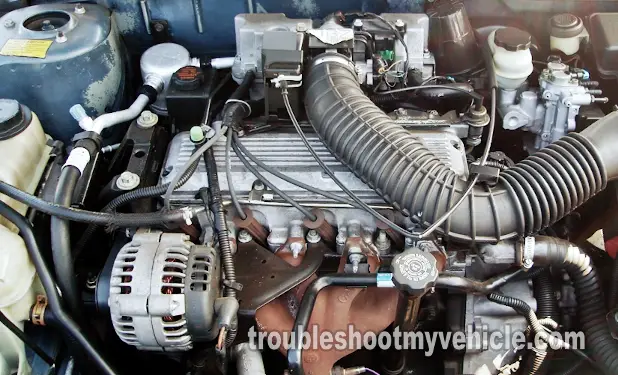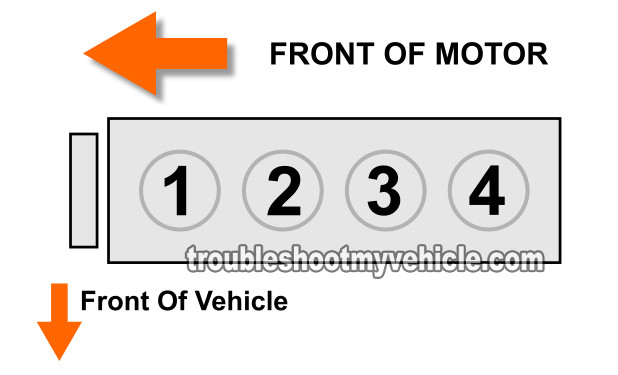
If one or more fuel injectors go bad on your GM 2.2L equipped vehicle, they'll usually set the dreaded misfire codes: P0300, P0301, P0302, P303, P0304. In some instances, the PCM might set a specific fuel injector code alerting you of the specific fuel injector it thinks is bad.
In this tutorial I'll show you how to do an easy multimeter resistance test on the fuel injectors to test for a bad fuel injector. I'm also gonna show you a simple strategy I use to find the bad fuel injector. This diagnostic strategy will help you pin-point the problematic fuel injector (when the injector resistance test doesn't).
This tutorial is a part of a series of engine cylinder misfire troubleshooting tutorials for your 2.2L GMC, Chevy or Pontiac equipped car or pick up. The starting point of this series is: How To Diagnose Misfire Codes (GM 2.2L).
Contents of this tutorial:
Tools You'll Need:
- Multimeter
- Pen and Paper
Symptoms Of A Bad Fuel Injector
Fuel injectors usually suffer one of two problems:
- Internal Electrical Problem: The fuel injector suffers either an open-circuit or a short-circuit problem, causing it to stop spraying fuel.
- Injector Gets Clogged: This is super common – eventually, they get all gunked up and clogged. When that happens, they can't spray the fuel in the right pattern and the cylinder (the fuel injector sprays into) will start misfiring.
Whether the fuel injector gets clogged or fails internally, you'll usually see one or more of the following symptoms:
- Rough Idle: Your car's engine may shakes or feel rough when you're stopped at a red light or just sitting in park. This happens because the injector isn't spraying fuel evenly or not at all into the engine.
- Cylinder Misfire: When one or more fuel injectors are clogged or malfunctioning, it'll lead to engine cylinder misfires. This means your engine might jerk or hesitate while you're driving, especially when you accelerate. You might see one of the following diagnostic trouble codes stored in the PCM's memory:
- P0300: Random Cylinder Misfire.
- P0301: Misfire In Cylinder #1.
- P0302: Misfire In Cylinder #2.
- P0303: Misfire In Cylinder #3.
- P0304: Misfire In Cylinder #4.
- Bad Gas Mileage: If your car suddenly starts guzzling gas more than usual, it could be because a fuel injector isn't working efficiently. When injectors are clogged or not spraying fuel properly, your engine has to work harder and uses more fuel to keep going.
- Difficulty Starting: Sometimes, when a fuel injector is clogged or not working right, your car might have trouble starting up. It might take a few tries before the engine finally catches and starts running smoothly.
- Check Engine Light: If your car's computer detects a problem with the fuel injectors causing an engine cylinder misfire and illuminating the check engine light.
Where To Buy The Fuel Injector And Save
The fuel injector can get expensive and the best place to save some bucks on it is by shopping for it online.
The following links will help you comparison shop for the original AC Delco/Delphi, and after-market fuel injector:
Disclosure: As an Amazon Associate, I earn from qualifying purchases. If my tutorials help you, using these links is an easy way to support the site at no extra cost to you. Thank you!
NOTE: Not sure if the fuel injector fits your particular vehicle? Don't worry. Once you get to the site, they'll ask you for the details of your vehicle (to make sure it fits). If it doesn't fit, they'll find you the right one.
The Fuel Injector Test

Your car's engine needs to be slightly warmed up for this test, but not completely cold. If the engine has been running for an extended amount of time, let it cool down about 1 hour. If you have a scan tool, you can verify that the engine coolant temperature (ECT) sensor reading should be no less and no more than 100° F.
To be able to accommodate all types of experience levels, and to keep this test as simple as possible, the following steps assume that you'll be testing all 4 fuel injectors.
Let's get started:
- 1
Disconnect all four fuel injectors from their electrical connectors.
NOTE: Be careful, the connectors are made out of plastic and could easily break. Take your time disconnecting them. - 2
Set the multimeter to Ohms (Ω) mode.
- 3
Measure the fuel injector's resistance across its two male terminals with the multimeter probes
- 4
Write down on a piece of paper the Ohms value and what cylinder that reading belongs to.
The fuel injector resistance should be around 1.9 to 2.3 Ohms (although on your specific GM 2.2L car or pick up, this value might be a little different). - 5
Repeat test steps 2 through 4 on the remaining 3 fuel injectors.
Alright, with the resistance values in hand, of all four fuel injectors, let's interpret your results. Choose from one of the following CASES:
CASE 1: All of the multimeter resistance values are nearly identical. This result indicates that the fuel injectors are OK and are not causing the misfire code or condition.
If your 2.2L equipped GM vehicle is still suffering a rough idle/misfire problem, then there's a good chance that the problem is being caused by low compression in one engine cylinder or a bad spark plug wire/bad ignition coil. For more troubleshooting ideas, take a look at the following section: Fuel Injector Troubleshooting Guide and the following tutorial:
CASE 2: One of the four multimeter resistance values is drastically different: Retest all four fuel injectors to confirm the initial resistance values your multimeter registered. If they are the same as before, then the fuel injector that registered the different resistance value is bad. Replace the fuel injector.
If you're interested in saving some bucks on the original AC Delco/Delphi fuel injector, take a look at the section: Where To Buy The Fuel Injector And Save.
Which Fuel Injector Do I Test First? Or Do I Test All Of Them?
It's best to test all of the 4 fuel injectors on your GM 2.2L equipped car or pick up (Cavalier, S10, Sunfire, Sonoma). This way, you'll have a clear idea of what the resistance value should be for all 4 fuel injectors.
To explain this a bit further, let me say that you need to keep the following two important points in mind:
- All fuel injectors have a specific internal resistance that can be measured in Ohms mode on a multimeter.
- When a fuel injector goes bad, it'll normally have a completely different resistance value than the other ones.
Therefore, the purpose of the test is to find the bad fuel injector by reading it's resistance and comparing this reading to two other fuel injectors.
If you have a scan tool and you have specific misfire code, test the fuel injector that correspond to the diagnostic trouble code and then test two more, so that you'll have those two resistance readings to compare.
If you don't have a specific misfire code to go on, well that's OK too, just test all of the fuel injectors.



